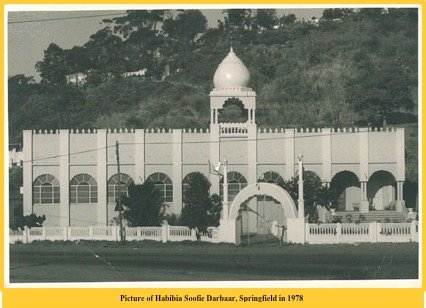In the midst of desolate wilderness, a little musjid was established by His Eminence, Hazrat Hajee Shah Ghulam Mohammed Soofie Siddiqi (R.A.). The area was a poorly inhabited place called Buttery Place. It was a swampy area but with farming potential due to the abundance of springs, hence the present name, Springfield. The original structure was a modest structure which was slowly completed by 1907.
The inhabitants were far and few, but with the karam of Allah, the musjid was kept going. As Hazrat Soofie Saheb (R.A.) busied himself with other building projects such as the Soofie Musjid in Glenearn Road, he appointed the residents of Buttery Place to take care of the musjid. After the demise of Hazrat Soofie Saheb in 1910, the gradual increase in population necessitated the services of an illuminary who could tend to the needs of the community, as well a create a centre of learning, for the advancement of the Chishtia Silsila. Upon the instructions of his eldest brother – Hazrat Shah Mohammed Ebrahim Soofie (R.A.); Hazrat Shah Mohammed Habeeb Soofie (R.A.) (Jhande Peer) was appointed to take charge of the musjid in Buttery Place, and to continue the work of his illustrious father, Hazrat Soofie Saheb (R.A.).
Hazrat Jhande Peer (R.A.) took charge of the Astana in 1939. The living conditions were unbearable, and innumerable sacrifices were made by Hazrat Jhande Peer and his family. The musjid was in a poor condition, and in 1942, renovations got underway to improve the facilities. It was the daily task of Hazrat Jhande Peer to call people for Salaat. Armed with a lantern Hazrat used to climb and tread through dangerous terrain to invite people to the musjid.
Hazrat Jhande Peer also established a Madrassa which children began attending to obtain Islamic knowledge. Classes at the Madrassa were conducted by the wife of Hazrat Jhande Peer; a service which she rendered free of charge for twenty one years.
As Buttery Place began to flourish, Hazrat Jhande Peer saw the need for an extension to the musjid and Madrassa. The musjid and Madrassa was extended once again in 1957 with a new wudhu block being added as well. As Hazrat’s health began to wane, Hazrat instructed his son, Hazrat Shah Noor Mohammed Soofie to assist him in managing the affairs of the Astana. Hazrat Shah Noor Mohammed took his English education “wrapped it in a parcel and cast it into the sea” and began assisting his father in earnest. Upon the demise of Hazrat Jhande Peer in 1968, Hazrat Shah Noor Mohammed Soofie was appointed trustee of the Soofie Astana by the congregation in accordance with the dictates laid down by Hazrat Soofie Saheb (R.A.) in the Hazrat Shah Ghulam Mohammed Trust.
Hazrat Shah Noor Mohammed Soofie was found capable of filling his illustrious father’s place. He is a direct descendant, was elected by the congregation and was worthy of such a position. In keeping with the above stipulation as laid down by the Trust Deed; Hazrat Shah Noor Mohammed Soofie was initiated as Trustee.
The Muslim community in Spring- field began increasing and Hazrat Shah Noor Mohammed Soofie catered for the needs of the communi- ty, and continued in the footsteps of his illustrious father. By 1975, Haz- rat Shah Noor Mohammed Soofie’s two sons, namely Hazrat Imam Javed Soofie Chishti Al-Habibi and Hazrat Imam Khalid Soofie had come of age, and upon the request of their father, sacrificed their youth to be at the side of their father and to assist him in the management of the Astana and the propagation of Deen, and the advancement of the Chishtia order. In 1978. with the exceptional help of the Hajee A G Joosub family (Atomic Demolishers). the musjid and Madrassa as extensively renovated, which brought the structure to its present size. The teaching at the Madrassa continued. with hundreds of students gaining fruitful Islamic knowledge. In 1986, a Ladies’ Jamaat Khana was built adjacent to the musjid. This once again was a fruit- ful step as it catered for the women of the community; a service which was in great demand for the spiritual upliftment of the ladies of the community.
Owing to ill health, Hazrat Shah Noor Mohammed Soofie retired in 1989. The two imams: Hazrat Imam Javed Soofie Chishti Al-Habibi and Hazrat Imam Khalid Soofie were unanimously elected by the congre- gation as per dictates of the Hazrat Hajee Shah Ghulam Mohammed Trust’s Trust Deed.
In 1990 the newly-elected trustees decided that extensive refurbishments to the musjid were required. Two new minarets were added; and the interior was improved with new carpets and air conditioner installed. The wudu-khana was also revamped. This was made possible by the Muslim community in general.
In 1992 the wisaal of Hazrat Shah Noor Muhammad Soofie took place. At this juncture, the 2 Imams took the entire weight of running the Astana upon them- selves and worked on extending the masjid to cater for growing needs of the community.
An additional building was added to the site that now serves as a Montessori school and Madrassa.
During 1995 the community of Phoenix requested the trustees of Masjide Soofia, Springfield to assist in the building and running of an Astana according to the methods taught by Hazrat Soofie Saheb (R.A). This gave rise to the present establishment of the Astana in Phoenix that is now run by Hazrat Shah Imam Khalid Soofie. This is an achievement and a testament to the reach and effect of the work started by Hazrat Soofie Saheb (R.A) himself. Not only is it limited to the Astana’s built by him but also is extending out into further communities that are benefiting from this pioneers early work. It is at this Astana also that a Madrassa and the activities synonymous with the activities running at Masjide Soofia in Springfield continue to take place under the Chishti Habibi Flag.
